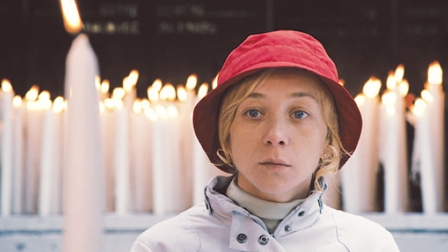Lourdes (Jessica Hausner, 2009): Austria, France, Germany
Reviewed by Lava Farmer. Viewed at the Santa Barbara Film Festival.

Lourdes is the story of a young woman named Christine (Sylvie Testud) who journeys to the village of Lourdes in hopes that she might be the recipient of a miracle. She is bound to a wheelchair by multiple sclerosis, but like most who travel to the historic commune of Lourdes, she wishes desperately for her ailments to be miraculously cured by the healing powers of the holy spring water. Although, unlike many of her fellow pilgrims, she seems more determined than faithful. She explains that she is frustrated with her unfortunate situation, and yet she is still oddly at ease, as though if she concentrates hard enough she’ll be able to will herself better.
Like the characters we are following, we as an audience are somewhat bound in place. Director Jessica Hausner gives us stationary shots in which the camera movement is minimal or nonexistent. Often we are given a shot of a group of people, then left behind as they all exit the shot and leave us to stare at the set that’s left. This is perhaps to give us a feeling of loneliness and isolation, like that felt by our helpless heroine. Many shots of Christine seem to linger and force us to focus on how she’s feeling and leave us wondering what she’s thinking. The use of very stable and linearly framed shots she also gives us a sense of security, which is emphasized by the familiarity we gain from watching the characters carry out their daily routines. In this way Hausner uses the camera to make us feel stuck in the same kind of bored, frustration that Christine expresses in her prayers.
There is, however, an air of humor throughout the film which lightens the mood. The two skeptical older woman on the pilgrimage are constantly making snide comments that you just can’t help, but snicker at. They pray for healing of the soul and yet they are constantly gossiping and doubting. They are ridiculously hypocritical when it comes to miracles and those who have received them, making them a stark contrast to all the desperately, faithful believers. When Christine seems to be the recipient of a miracle, everyone around her seems somewhat jealous. Everyone wants a miracle of their own and can’t help, but wonder why it happened to her and not someone more deserving. However, we as an audience know that it isn’t a miracle that will last.
The surprisingly witty film is both inspiring and introspective. Through the use of cynicism we are forced to question our own morals and faith. In one scene, a statue of the Virgin Mary sports a glowing neon halo that illustrates the hypocrisy of her overwhelming presence. In this way Hausner is able to show us the greedy side of religion. She shows us that even the most faithful believers are only in it for their own salvation and no one is exempt from jealousy.
About this entry
You’re currently reading “Lourdes (Jessica Hausner, 2009): Austria, France, Germany,” an entry on Student Film Reviews
- Published:
- 02.12.10 / 8am
- Category:
- Films, Santa Barbara Film Festival 2010
1 Comment
Jump to comment form | comments rss [?] | trackback uri [?]